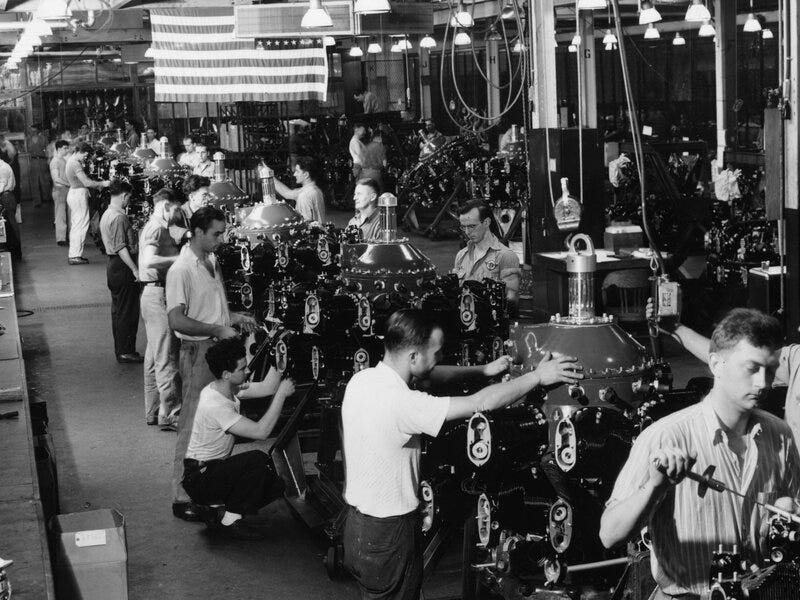Standing in the Rose Garden and holding a red “Make America Great Again” hat, President Donald Trump announced that he had very good news for the country.
“My fellow Americans, this is Liberation Day,” he said. “April 2, 2025, will forever be remembered as the day American industry was reborn, the day America’s destiny was reclaimed, and the day that we began to make America wealthy again. . . . For decades our country has been looted, pillaged, raped, and plundered by nations near and far, both friend and foe alike.”
Those years were over, Trump said. Jobs would no longer be “stolen” or U.S. factories “ransacked” by “foreign leaders and foreign cheaters,” he told the crowd seated on the grass.
With a half-dozen large American flags blowing in the breeze, Trump announced that he would sign an executive order instituting reciprocal tariffs on about 90 countries and locales, including uninhabited islands whose shores teem not with tired, poor, huddled masses yearning to breathe free, but instead with penguins. Since April 2, the stock market has been in a free fall, and Trump continues to threaten even more tariffs on China, which would bring the tariff on some Chinese goods to more than 100%.
Despite the markets’ terror, Trump has stayed the tariff course, saying that tariffs will return the American economy back to the times when manufacturing was booming and a factory job paid enough that a worker’s wife could stay home with the kids.
But here’s the thing no one is talking about: The manufacturing jobs of yore paid enough to sustain the average family on a single income, and that is no longer true. The jobs that many of our grandparents worked at often no longer provide a living wage for a single individual, let alone a family of four. Wages have not kept pace with what it costs to live a middle-class lifestyle.
Why U.S. manufacturing moved abroad
High pay in factory jobs and wide public support of unionization led to a boom in manufacturing jobs in the decades following World War II. Because of the war, the production capacity of much of Europe and Japan was greatly reduced, and the United States picked up the slack.
American manufacturing peaked in 1979, when nearly 20 million people were employed in the sector — at the time, this was more than a quarter of all employment in the US. America was one of the world’s top producers of cars, aircraft, and steel.
The reason for the decline of manufacturing is multifaceted. The stagflation of the 1970s gave way to a recession in the early 1980s. Other countries finally rebuilt their capacity after the war, and the world was increasingly automated. Jobs began to shift overseas due to lower labor costs.
Another reason for the shift was that Japanese manufacturing became superior to the factories in the United States, and so American companies began outsourcing their manufacturing to Japan. Shipping goods internationally also became much faster and cheaper in the post-war era, making it easier for companies to make something abroad and ship it to the U.S.
What a factory job could provide during the industry’s prime
I’m sure you’ve heard tell of the time when a father clocked into his job at 9:00 a.m., worked for eight hours, and then, when work was done, rolled into the driveway of his three-bedroom house in a new Chevrolet. Meanwhile, his progeny were being lovingly cared for by a stay-at-home mother, who had meatloaf waiting in the oven upon his arrival. Often, men worked at their factory jobs for many decades and then earned a pension, which allowed them to retire comfortably.
How did they do it? Life, in general, was cheaper — and wages have not kept up with rising costs.
In 1950, the average factory worker made about $1.47 per hour — around $3,000 per year. Today, the average manufacturing job across all roles outside of supervisory positions brings in about $28.92 per hour. At the average hourly wage, a worker would end up making about $58,000 for the year, assuming they took a two week vacation. It’s easy to look at these numbers and think that people should be able to keep up: they are making nearly 20 times what the average factory worker was in 1950. But the evidence shows otherwise.
The average home in 1950 cost $7,354, about 2.5 times the average yearly income of a factory worker.
A typical home in 2025 costs $357,000 — and that is just an average from around the country. In many large metro areas, one could not purchase an average home for this price. Rather than costing 2.5 times their yearly pay, the average home is now more than six times the average factory worker’s income.
Homebuyers in 30 states and D.C. need a six-figure household income to afford even a typical home. That’s an 80% increase in what someone needed to make to be able to comfortably buy a home in 2020.
A buyer looking to purchase a new vehicle in 1950 would expect to spend about $1,299, or 43% of their annual income. In 2025, the average price of a new car is $48,461, or 84% of the average factory worker’s income.
Tuition was also very different for our grandparents. The average undergraduate tuition and fees at a public university in 1952–53 were about $150, while at private institutions they were $550.
This would amount to about 5% of their yearly take-home cash. Now? That undergraduate degree will run in-state students about $11,610 a year— that’s about 20% of the average factory worker’s annual earnings. And that is JUST tuition, not including room and board, books, and the like. Private universities have a higher price tag. Tuition alone averages $43,350, nearly 75% of a manufacturing employee’s salary.
Healthcare is one of the most expensive things Americans pay for — a cost that’s impossible to compare with that of the average household in the 1950s, when the insurance system was quite different from today’s. In 1950, the average family paid about $200–225 annually for medical care. This included premiums and out-of-pocket costs.
It is a completely different story now. Since 2014, insurance costs have gone up by 52% for a typical family. In premiums alone, the average family pays nearly $6,100 each year, while some pay just over $14,000. This doesn’t include co-pays or anything else — JUST premiums, according to the Bureau of Labor Statistics. In out-of-pocket costs, our forebears paid around 6% a year, but today the average manufacturing worker can expect to pay 10–25% of what they earn just for health-insurance premiums.
And these numbers don’t even touch another significant expense for 2025 families that simply wasn’t a consideration for the 1950s: day care. The national average cost of day care is $11,582 a year, or about 20% of the average factory worker’s salary.
Why are things so much more expensive?
Your grandparents were better able to afford the basics, like housing. (And none of the prices in this piece include potential increases due to tariffs.)
You are worse-off than they were because wages no longer match the average cost of living anymore. In 2018, the average wage had the same purchasing power as it did 40 years prior. A study in 2024 showed that for every pay increase lower-wage earners got, the income of top earners increased even more. Top earners make almost five times more than lowest-income workers (or 489% as much). A top earner is someone in the highest income bracket.
Many factors contribute to this “wage stagnation.” Labor unions are not as common, leaving workers with fewer resources and less power in contract negotiations. Automation has taken over some jobs. And the people at the top make decisions that benefit them, adding to income inequality.
The average worker is getting priced out of what used to be an average lifestyle because even though they are working just as hard, their pay is barely growing.
With all this in mind — and even if we create millions of new manufacturing jobs in the US and take back control from overseas companies — it’s clear that we won’t soon return to a bygone era in which the average factory worker could care for their family on a single income.









The inequality between the top 1% of wealth in this country and the bottom 50% is staggering and it’s the greatest failure IMO of this country and I think was one of main reasons DT won the election in 2016 and 2024. Unfortunately his populist rhetoric is just an illusion. The massive tax cuts for the ultra wealthy and big corporations will be his big “Ta Da!” moment and his people will cheer and wave the flag and say “see what a great leader he is?” In the end he will get richer along with Wall Street and CEOs but there will be no celebrating in the Main Streets because small businesses will be forced to close due to inflation and tariffs, farmers will go under if they don’t get a hand out from the government, and manufacturing jobs will be fewer than expected because even if they do come back to the states the automation of the machines and AI will make human labor obsolete. DT has no intention of running a country or helping make people’s lives better. He’s about performative political drama, retribution and making money for himself, his family and closest friends. That’s all he cares about and he’s very good at it.
Also worth pointing out that the fear generated around Social Security "running out" of money usually blames the easy (but inaccurate) target of too many Baby Boomers retiring at once, when the much larger issue is wage stagnation and widening income inequality that the funding models did not account for and have yet to correct.